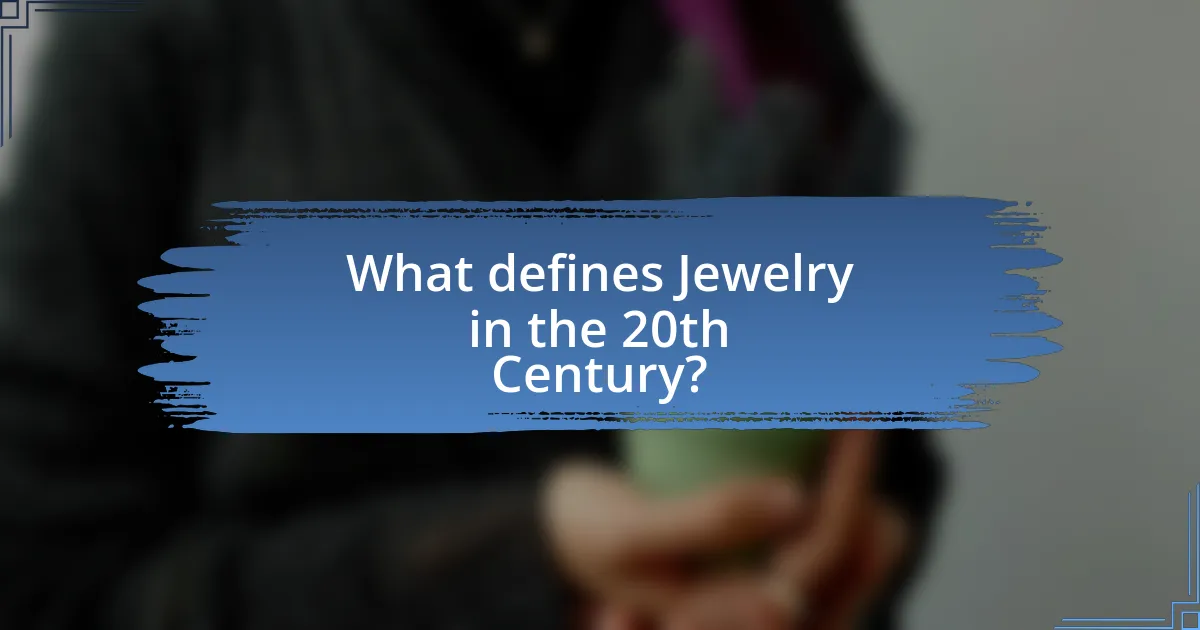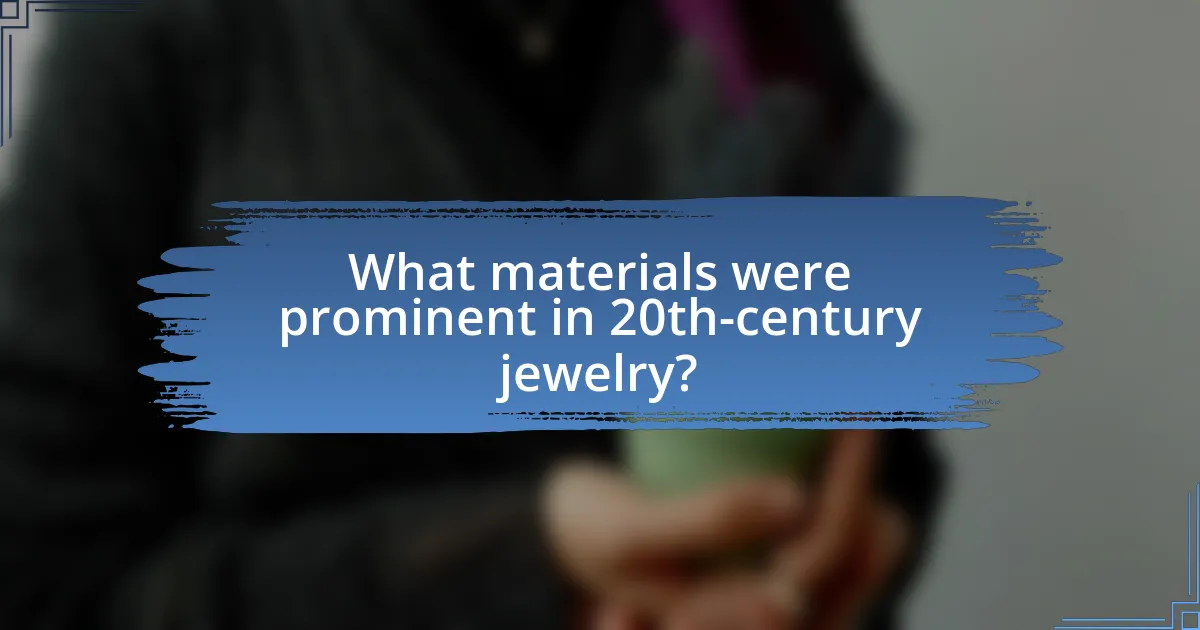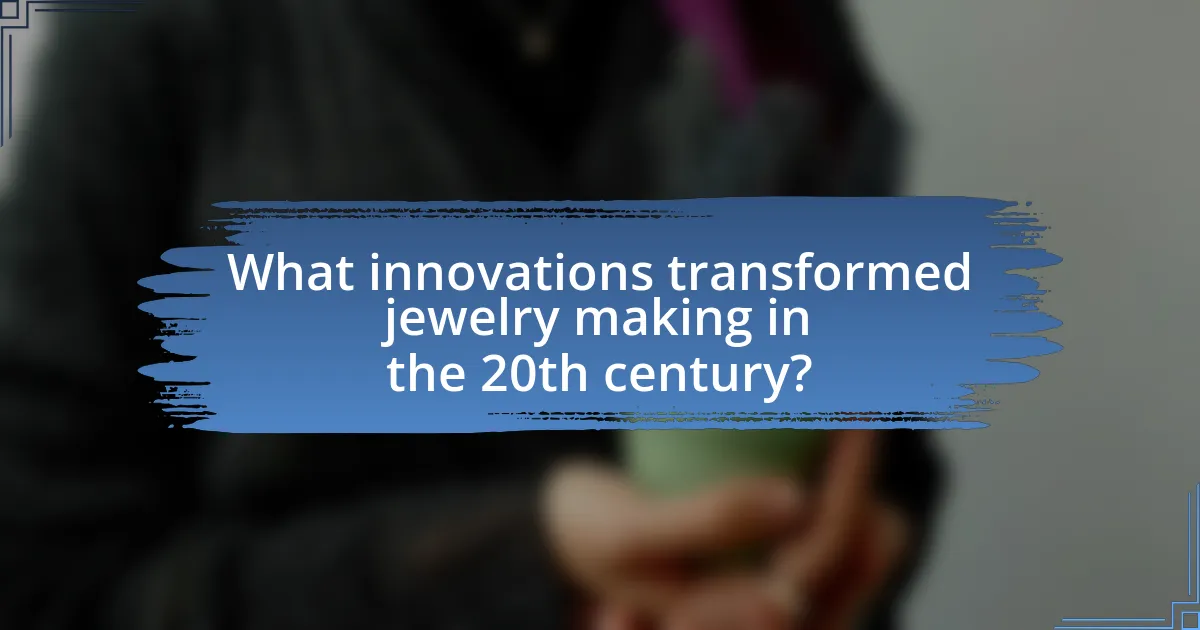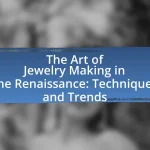Jewelry in the 20th century is characterized by diverse styles, innovative materials, and the influence of significant cultural movements. Key movements such as Art Deco, Modernism, and the Arts and Crafts movement shaped design aesthetics, while historical events like World Wars and the Great Depression impacted material availability and consumer preferences. The introduction of synthetic materials and advancements in technology transformed production techniques, allowing for greater creativity and accessibility in jewelry design. Notable gemstones, including diamonds, emeralds, and sapphires, gained prominence, reflecting societal trends and marketing strategies. This article explores the evolution of jewelry throughout the century, highlighting the interplay between historical context, design movements, and material innovations.

What defines Jewelry in the 20th Century?
Jewelry in the 20th century is defined by its diverse styles, innovative materials, and the influence of cultural movements. The century witnessed the emergence of Art Deco, which emphasized geometric shapes and bold colors, alongside the rise of modernism that favored minimalism and functionality. Additionally, advancements in technology allowed for the use of new materials such as plastics and synthetic gemstones, expanding the possibilities of design. The impact of historical events, such as World War I and II, also shaped jewelry trends, leading to more practical and affordable pieces. These factors collectively illustrate the dynamic evolution of jewelry throughout the century.
How did historical events influence jewelry design during this period?
Historical events significantly influenced jewelry design in the 20th century by reflecting societal changes, technological advancements, and cultural movements. For instance, the aftermath of World War I led to a shift towards more minimalist and functional designs, as seen in Art Deco jewelry, which emphasized geometric shapes and modern materials. The Great Depression further impacted jewelry trends, resulting in the popularity of costume jewelry that provided an affordable alternative to fine pieces. Additionally, the rise of feminism in the 1960s and 1970s inspired jewelry that challenged traditional gender norms, with designers creating bold, statement pieces that symbolized empowerment. These historical contexts shaped the aesthetics, materials, and purposes of jewelry, making it a mirror of the evolving social landscape.
What major wars and movements impacted jewelry trends?
Major wars and movements that impacted jewelry trends include World War I, World War II, and the Art Deco movement. World War I led to a shift towards simpler, more practical designs due to resource scarcity, while World War II saw the introduction of synthetic materials and a focus on patriotic themes in jewelry. The Art Deco movement, which emerged in the 1920s, emphasized geometric shapes and bold colors, reflecting the cultural changes of the time. These events significantly influenced the styles, materials, and themes prevalent in jewelry during the 20th century.
How did social changes shape the styles and materials used in jewelry?
Social changes significantly influenced the styles and materials used in jewelry throughout the 20th century. For instance, the rise of feminism in the 1960s led to the creation of more unisex and bold designs, reflecting a shift towards gender equality and individual expression. Additionally, the economic fluctuations, such as the Great Depression, prompted a move towards more affordable materials like base metals and synthetic stones, as luxury items became less accessible. The Art Deco movement, emerging in the 1920s, showcased geometric designs and the use of new materials like chrome and Bakelite, aligning with the modernist ideals of the time. These shifts in societal values and economic conditions directly shaped the evolution of jewelry styles and materials, demonstrating the interplay between culture and craftsmanship.
What are the key movements in 20th-century jewelry?
The key movements in 20th-century jewelry include Art Nouveau, Art Deco, Modernism, and Postmodernism. Art Nouveau, prominent from the late 19th century into the early 20th century, emphasized organic forms and intricate designs, often inspired by nature. Art Deco, which emerged in the 1920s, showcased geometric shapes, bold colors, and luxurious materials, reflecting the optimism of the Roaring Twenties. Modernism, gaining traction in the mid-20th century, focused on simplicity and functionality, often utilizing new materials and techniques. Postmodernism, emerging in the late 20th century, challenged traditional aesthetics and embraced eclecticism and irony in design. Each movement significantly influenced the evolution of jewelry design and craftsmanship during the century.
What characterized Art Deco jewelry?
Art Deco jewelry is characterized by its bold geometric designs, vibrant colors, and the use of innovative materials. This style emerged in the 1920s and 1930s, reflecting the modernist movement and the influence of technology and industrialization. Art Deco pieces often incorporated materials such as platinum, diamonds, and colored gemstones, showcasing intricate craftsmanship and a departure from the ornate styles of previous eras. The emphasis on symmetry and streamlined forms in Art Deco jewelry aligns with the broader aesthetic principles of the Art Deco movement, which celebrated modernity and luxury.
How did Modernism redefine jewelry aesthetics?
Modernism redefined jewelry aesthetics by emphasizing simplicity, abstraction, and the use of new materials, moving away from traditional ornamentation. This movement, which emerged in the late 19th and early 20th centuries, prioritized functional design and geometric forms, reflecting broader cultural shifts towards minimalism and industrialization. Notable designers like Georg Jensen and the Bauhaus school incorporated these principles, leading to innovative pieces that often featured materials such as silver, glass, and plastics, which were previously underutilized in fine jewelry. The shift towards these modernist ideals marked a significant departure from the ornate styles of the past, establishing a new visual language in jewelry that focused on form and material over decoration.
What role did the Arts and Crafts movement play in jewelry making?
The Arts and Crafts movement significantly influenced jewelry making by emphasizing handcrafted techniques and the use of natural materials. This movement, which emerged in the late 19th century, rejected mass production and industrialization, advocating for the artistry and individuality of handmade items. Jewelry designers associated with the Arts and Crafts movement, such as Charles Rennie Mackintosh and Edward Burne-Jones, focused on creating unique pieces that reflected personal expression and craftsmanship. Their work often incorporated organic forms, intricate detailing, and the use of semi-precious stones, aligning with the movement’s principles of beauty and functionality. This emphasis on artisanal quality and aesthetic value laid the groundwork for future jewelry design in the 20th century, influencing subsequent movements like Art Nouveau and Art Deco.

What materials were prominent in 20th-century jewelry?
Prominent materials in 20th-century jewelry included gold, platinum, silver, and various gemstones such as diamonds, sapphires, and emeralds. Gold and platinum were favored for their durability and luster, while silver gained popularity for its affordability and versatility. Gemstones were often used to enhance the aesthetic appeal of pieces, with diamonds being particularly sought after for their brilliance. The use of synthetic materials, such as plastics and resin, also emerged, reflecting the era’s innovative spirit and changing tastes in design.
How did the availability of materials change throughout the century?
The availability of materials for jewelry changed significantly throughout the 20th century due to industrial advancements and shifts in consumer demand. Early in the century, precious metals like gold and silver were primarily sourced from traditional mining, but by the mid-century, the introduction of synthetic materials, such as plastics and lab-created gemstones, expanded options for designers and consumers. For instance, the development of Bakelite in the 1920s provided a new, affordable alternative to traditional materials, while the later invention of cubic zirconia in the 1970s offered a synthetic substitute for diamonds. These innovations not only increased the variety of materials available but also made jewelry more accessible to a broader audience, reflecting changing social dynamics and economic conditions throughout the century.
What synthetic materials emerged and how were they used?
Synthetic materials that emerged in the 20th century include plastics, synthetic gemstones, and resins. Plastics, such as Bakelite, were used in jewelry design for their versatility and affordability, allowing for bold colors and innovative shapes. Synthetic gemstones, like cubic zirconia and moissanite, provided alternatives to natural stones, offering similar aesthetics at lower costs and increased durability. Resins were utilized for their ability to be molded into intricate designs, often incorporating colors and patterns that were not possible with traditional materials. These synthetic materials revolutionized jewelry making by expanding design possibilities and making jewelry more accessible to a broader audience.
How did the use of traditional materials evolve?
The use of traditional materials in jewelry evolved significantly throughout the 20th century as artisans began to incorporate modern techniques and influences. Initially, traditional materials such as gold, silver, and gemstones dominated jewelry design, reflecting cultural heritage and craftsmanship. However, as the century progressed, the introduction of synthetic materials, innovative techniques, and changing aesthetic preferences led to a diversification in material usage. For instance, the Art Deco movement embraced geometric designs and incorporated materials like enamel and platinum, while later movements, such as Modernism, experimented with unconventional materials like plastics and found objects. This evolution illustrates a shift from purely traditional craftsmanship to a more experimental and inclusive approach, reflecting broader societal changes and technological advancements.
What are the most notable gemstones used in 20th-century jewelry?
The most notable gemstones used in 20th-century jewelry include diamonds, emeralds, sapphires, and rubies. Diamonds became increasingly popular due to advancements in cutting techniques and marketing strategies, particularly the “A Diamond is Forever” campaign launched by De Beers in the 1940s. Emeralds were favored for their vibrant green color and were often used in Art Deco designs. Sapphires gained prominence, especially in royal jewelry, highlighted by the engagement ring of Princess Diana, which featured a blue sapphire. Rubies, known for their deep red hue, were also widely used, particularly in vintage and retro styles. These gemstones not only defined the aesthetics of the era but also reflected the cultural and economic trends of the time.
Which gemstones gained popularity and why?
Emeralds, sapphires, and diamonds gained popularity in the 20th century due to their association with luxury, status, and advancements in mining and marketing. Emeralds became favored for their vibrant green color and were prominently featured in Art Deco jewelry, while sapphires gained attention through royal endorsements, notably Princess Diana’s engagement ring. Diamonds saw a significant rise in popularity due to successful marketing campaigns, such as De Beers’ “A Diamond is Forever,” which established them as the ultimate symbol of love and commitment. These factors collectively contributed to the gemstones’ elevated status in jewelry design during the century.
How did gemstone treatments and enhancements impact jewelry design?
Gemstone treatments and enhancements significantly influenced jewelry design by expanding the range of colors, clarity, and overall appeal of gemstones. These treatments, such as heat treatment, dyeing, and laser drilling, allowed designers to utilize stones that were previously considered less desirable due to imperfections or lack of vibrant color. For instance, heat treatment can enhance the color of sapphires and rubies, making them more attractive and marketable. This innovation led to a greater variety of designs and styles, as jewelers could incorporate these enhanced stones into intricate settings, catering to evolving consumer preferences for unique and visually striking pieces. The widespread acceptance of treated gemstones also prompted changes in pricing structures and consumer education, as buyers became more aware of the differences between natural and treated stones.

What innovations transformed jewelry making in the 20th century?
Innovations that transformed jewelry making in the 20th century include the introduction of new materials, advancements in technology, and the rise of modern design movements. The use of synthetic gemstones and alternative materials like plastics and resins allowed for more affordable and diverse jewelry options. Technological advancements, such as laser cutting and computer-aided design (CAD), enabled precision and creativity in jewelry design, allowing artisans to create intricate patterns and forms that were previously impossible. Additionally, movements like Art Deco and Modernism influenced aesthetic approaches, emphasizing geometric shapes and bold colors, which reshaped consumer preferences and artistic expression in jewelry. These innovations collectively revolutionized the industry, making jewelry more accessible and varied in style.
How did technology influence jewelry production techniques?
Technology significantly influenced jewelry production techniques by introducing advanced machinery and methods that enhanced precision and efficiency. The advent of computer-aided design (CAD) allowed jewelers to create intricate designs with high accuracy, reducing the time required for prototyping. Additionally, laser cutting technology enabled the production of complex shapes and patterns that were previously difficult to achieve by hand. The use of 3D printing further revolutionized the industry by allowing for rapid prototyping and customization of jewelry pieces, making it easier for designers to experiment with new forms and materials. These technological advancements not only improved the quality of jewelry but also expanded the creative possibilities for designers, leading to innovative styles and techniques in the 20th century.
What advancements in tools and machinery changed the craft?
Advancements in tools and machinery that changed the craft of jewelry in the 20th century include the introduction of electric tools, laser cutting technology, and computer-aided design (CAD). Electric tools, such as rotary tools and powered saws, significantly increased efficiency and precision in metalworking and stone setting. Laser cutting technology allowed for intricate designs and patterns to be created with high accuracy, reducing material waste and enhancing creativity. CAD software revolutionized the design process, enabling jewelers to visualize and modify their creations digitally before production, which streamlined workflows and improved overall craftsmanship. These technological innovations collectively transformed jewelry making, allowing for greater complexity and personalization in designs.
How did computer-aided design (CAD) impact jewelry design?
Computer-aided design (CAD) significantly transformed jewelry design by enabling precision, efficiency, and creativity in the design process. CAD software allows designers to create intricate 3D models of jewelry, facilitating detailed visualizations and modifications before production. This technology reduces the time and cost associated with traditional hand-drawing methods and physical prototypes, as designers can easily iterate on designs and make adjustments in real-time. Furthermore, CAD has expanded the possibilities for complex geometries and innovative designs that were previously difficult to achieve, thus enhancing artistic expression in jewelry making. The adoption of CAD in the jewelry industry has led to increased production capabilities and has allowed for greater customization options for consumers.
What role did fashion and celebrity culture play in jewelry innovation?
Fashion and celebrity culture significantly influenced jewelry innovation by driving trends and consumer demand. Throughout the 20th century, high-profile figures such as movie stars and musicians showcased unique jewelry pieces, which led to increased popularity and sales of similar styles among the public. For instance, the iconic diamond engagement ring became a standard largely due to celebrities like Grace Kelly and Elizabeth Taylor, who popularized extravagant designs. Additionally, fashion designers collaborated with jewelers to create statement pieces that complemented their collections, further merging jewelry with fashion trends. This interplay between celebrity endorsements and fashion movements not only shaped aesthetic preferences but also spurred technological advancements in jewelry-making techniques, ensuring that the industry evolved in tandem with cultural shifts.
How did iconic figures influence jewelry trends?
Iconic figures significantly influenced jewelry trends by popularizing specific styles and materials through their public personas and fashion choices. For instance, celebrities like Audrey Hepburn and Elizabeth Taylor showcased luxurious pieces that emphasized glamour, leading to a surge in demand for statement jewelry in the mid-20th century. Additionally, figures such as Coco Chanel revolutionized jewelry by promoting the idea of mixing fine and costume jewelry, which encouraged a more eclectic and accessible approach to adornment. Historical events, such as the rise of Hollywood in the 1920s and 1930s, further amplified this influence, as movie stars became trendsetters, inspiring the masses to emulate their styles.
What impact did fashion houses have on jewelry design and marketing?
Fashion houses significantly influenced jewelry design and marketing by integrating high fashion aesthetics with jewelry, creating a symbiotic relationship that elevated both industries. This collaboration led to innovative designs that reflected contemporary fashion trends, as seen in the works of brands like Chanel and Dior, which introduced costume jewelry that was both accessible and stylish. Additionally, fashion houses utilized strategic marketing techniques, such as celebrity endorsements and fashion shows, to promote their jewelry lines, thereby enhancing brand visibility and desirability. For instance, in the 1950s, Dior’s jewelry collections were showcased alongside their haute couture, reinforcing the idea that jewelry was an essential component of a complete fashion ensemble. This approach not only transformed consumer perceptions of jewelry but also established it as a key accessory in the fashion industry.
What are the lasting impacts of 20th-century jewelry on contemporary design?
The lasting impacts of 20th-century jewelry on contemporary design include the integration of innovative materials, the embrace of artistic movements, and the emphasis on individuality. The use of unconventional materials such as plastics and resins, popularized by designers like Elsa Schiaparelli, has influenced modern jewelers to experiment beyond traditional metals and gemstones. Additionally, movements such as Art Deco and Modernism have left a legacy of geometric forms and bold aesthetics that continue to inspire contemporary designs. The focus on personal expression and unique craftsmanship, seen in the works of artists like Alexander Calder, has led to a greater appreciation for bespoke and artisanal jewelry today. These elements collectively shape the current landscape of jewelry design, reflecting a blend of historical influences and modern sensibilities.
How do modern jewelers draw inspiration from 20th-century movements?
Modern jewelers draw inspiration from 20th-century movements by incorporating design elements, materials, and philosophies that reflect the artistic trends of that era. For instance, the Art Deco movement, characterized by geometric shapes and bold colors, influences contemporary jewelry design through the use of streamlined forms and luxurious materials like platinum and colored gemstones. Additionally, the Bauhaus movement’s emphasis on functionality and simplicity can be seen in minimalist jewelry pieces that prioritize clean lines and innovative materials. These historical movements provide a rich context that informs modern aesthetics, allowing jewelers to create pieces that resonate with both historical significance and contemporary style.
What lessons can be learned from the innovations of the past?
Innovations in jewelry design during the 20th century reveal the importance of adaptability and creativity in responding to cultural shifts. For instance, the introduction of new materials like plastics and synthetic stones allowed jewelers to experiment with forms and colors, reflecting the era’s artistic movements such as Art Deco and Modernism. This adaptability not only expanded the boundaries of traditional jewelry but also demonstrated how societal changes, such as the rise of consumerism and the influence of technology, can drive innovation. The success of these innovations underscores the value of embracing change and exploring unconventional ideas in design, which can lead to unique and lasting contributions to the field.


